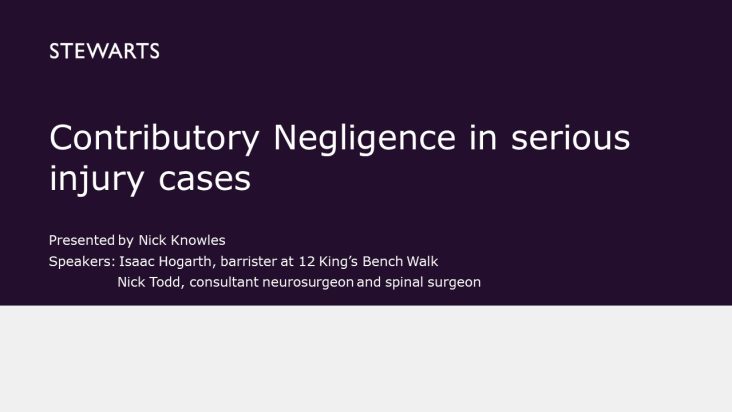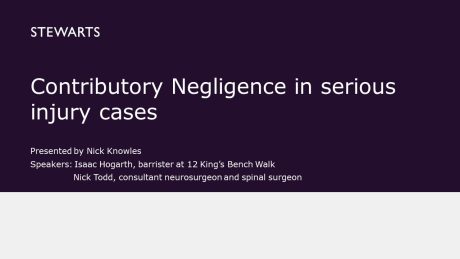Partner Nick Knowles recently welcomed Isaac Hogarth, barrister at 12 King’s Bench Walk, and Nick Todd, consultant neurosurgeon and spinal surgeon, to discuss the issue of contributory negligence in our latest expert witness training webinar. Contributory negligence is a partial defence that must be raised and pleaded by a defendant, arguing that a claimant has suffered damage partly as a result of their own fault.
You can view the recording here:

What is contributory negligence?
Introducing the topic of contributory negligence, Isaac explained that it can mean either contribution to the occurrence or extent of the damage, or both. An accident caused wholly by the claimant will of course render the whole claim invalid. On the other hand, if the claimant is blameworthy in some way but their breach has made no contribution to the damage as a matter of causation, there will be no contributory negligence per Caswell v Powell Duffryn Associated Coillieries Ltd [1940] AC 152).
The standard of care on the claimant is the same as generally applies in the law of negligence, ie what is reasonable in the circumstances. The claimant must take into account the possibility of others being careless, and must have had an opportunity to avoid injury. Children are not generally judged by the same standards as adults, and the extent to which blame may be attributed to a child depends on their age; disability is also taken into account.
Failure to wear a seatbelt is a good example of contributory negligence, with guidance given in the case of Froom v Butcher [1976] QB 286. Insurers can obtain no higher than 25% discount for contributory negligence in even the clearest case of injury being sustained wholly by the failure to wear a seatbelt, and 15% if the injury was more serious due to not wearing one.
Other common examples of potential contributory negligence include:
- Use of an improperly fitted or wrong type of child seat
- Failure to wear a crash helmet on a bicycle or motorcycle
- Accepting a lift from a driver the claimant knows to be intoxicated
There is no reason in principle why, in appropriate cases, contributory negligence cannot be raised in the context of clinical negligence claims, but this remains relatively uncommon and tends to arise only in certain circumstances. Obvious examples are claimants who are non-compliant with treatment, or who fail to seek treatment or advice upon symptoms developing. Instances of contributory negligence in clinical cases will be fact specific.
The medical perspective
In his role as a neurosurgeon and spinal surgeon, Nick Todd focused on the part played by bike helmets, seatbelts and airbags in crashes that can result in brain or spinal injury. He also considered the science behind assessing contributory negligence including the significance of delta velocity, impact speed, site of injury and type of restraint uses. Delta velocity in an injury context represents the change in velocity from immediately before to immediately after a collision, which occurs in a near-instantaneous 0.15 seconds.
Cycle helmets reduce the risk in the event of a crash of any head injury by 51%, of a severe head injury by 69%, and of a fatal head injury by 65%. The helmet reduces peak acceleration, allowing more time for the head and brain to ‘slow down’ and reducing the risk of a severe head injury. Helmets reduce the severity of direct fractures and contusion (coup injuries) as well as injuries opposite the impact site (contra-coup), but might have no effect on diffuse axonal injuries.
Seatbelts reduce the probability of a cervical spinal cord injury in the event of a severe road traffic collision. Based on a survey of 1,046 spinal cord injuries over 18 years, the probability of a spinal cord injury when not wearing a seatbelt was 0.145%, more than five times the probability when wearing one (0.027%). An airbag alone is insufficient to lessen the chances of an SCI occurring, and may be more likely to cause injury than no restraint at all.
You can find further information regarding our expertise, experience and team on our Clinical Negligence or Personal Injury pages.
If you require assistance from our team, please contact us.
Subscribe – In order to receive our news straight to your inbox, subscribe here. Our newsletters are sent no more than once a month.





